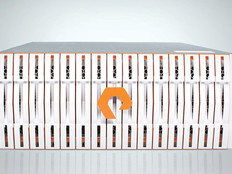Tiers of Joy: Florida State University Installs Fully Automated Storage Tiering
Even before Florida State University turned on EMC's VNX Fully Automated Storage Tiering (FAST) this summer, Randy McCausland, director of infrastructure and operations support, suspected he'd found the ideal complement to the server virtualization strategy deployed by the university years earlier.
FAST will help McCausland and his team address a range of user applications, from an ERP system with heavy concurrent I/O to an e-mail message sent to 300 professors but saved just once using deduplication.
EMC's FAST technology pools storage resources, then dynamically moves and places data around an organization's storage infrastructure as needs change.
McCausland managed the deployment of the new storage with Mary Stephenson and Johnny White, associate director and assistant director, respectively, within the university's Information Technology Services (ITS). The project is a $1 million procurement that over the next two years will replace the university's six existing mixed-manufacturer storage devices.
Through chargebacks to various campus units that lease storage space from his office, the investment should pay for itself, McCausland says.
"Some departments use our service for document storage and file collaboration, while others use it as a means to support their enterprise backup strategy," he says. "We're pretty open to how they leverage it. If it adds value to their operations, we think it's a win."
White says ITS found it challenging in the past to accurately predict the quality and composition of the university's storage environment, as there are an ever growing number of use cases that the institution must support. But FAST will let the university put all those applications into one footprint, conserving storage space and reducing management costs to boot, adds Stephenson.
Another bonus is that as storage space is further compressed over time, the fees McCausland's group charges to its customers will decrease.
Indiana University has also had success with a chargeback model – charging one dollar per gigabyte per year, says Rob Lowden, director of enterprise system infrastructure in UITS, IU's central IT group. At least part of the reason for the reduced cost is that a decade earlier IU standardized around virtualization.
That decision has had consequences for another area of the university's infrastructure: its storage. "Our servers have zero onboard storage," Lowden says, adding that "everything is on a consolidated storage area network or network-attached storage back end."
IU invested in Hitachi Data Systems storage five years ago, largely because of the manufacturer's commitment to virtualization, which Lowden says was a part of the university's plans.
Lowden says that at the time, the university took away direct-attached physical storage and initially gave all customers the kind of readily available, highly secure access to their data that would warrant a top-tier ranking. As time wore on, with more detailed tools and analysis, the team was better able to intelligently assign its systems to the appropriate tier, which was not always Tier 1. Now, Hitachi's automated tiering technology can help tackle that piece of the puzzle. That comes as a relief to UITS, which supports 110,000 students and 500,000 active accounts across eight campuses around the state.
Yet even with automation options, organizations must make intelligent choices about what data truly warrants top-tier storage, availability and backup, says Steve Brasen, managing research director at Enterprise Management Associates. This is especially true at colleges when they are charging back to academic departments whose budgets are much tighter today.
For example, Brasen says an ERP system containing sensitive and critical information would have to be highly secure and highly available. It would logically demand additional backup, disaster recovery and other add-on services delivered from a provider on or off campus. However, for student classwork and e-mail, cheaper cloud-based storage might make better sense.
Learn As You Go
Over time, most educational institutions fine-tune their understanding of how to store and secure clients' workloads – how they're used, how they are best stored, how much space they might occupy and where.
"We have continued to get a return on those investments in subsequent years as we become more knowledgeable about the workloads [UITS is charged with storing]," says Lowden. "We have always treated the data with kid gloves."
68%
The percentage of reduction in disk I/O contention from running EMC's FAST automated storage tiering
SOURCE: EMC
At the end of the day, storage tiering can ratchet up server virtualization's potential resource savings dramatically.
And, adds FSU's McCausland, it also lets him get the most out of the university's storage infrastructure, mixing and matching low- and high-performance disks more intelligently. Another bonus is that storage utilization has been enhanced by significant improvements in storage compression and deduplication.
"Our initial space savings through deduplication was around 21 percent, but as the storage system became more familiar with our customers' consumption, we have realized space savings approaching 50 percent for select customer use cases," FSU's White says.
In effect, "we can serve up more storage than we have physical space, and our backup resources are not as much in demand," he concludes.
"Things are really evolving," adds McCausland.
The Sanctity of Data
In academia, data is sacred, says Brian Haymore, storage team leader at the University of Utah's Center for High Performance Computing. "It's not something people are willing to be risky with," he adds.
At UofU, as it's known, both those generating the data and those charged with storing it securely have been rethinking how and what storage is – and what it can be, Haymore says.
"Our role has been patterned on the needs of the campus," he says. "Five or six years ago, we had been storing the traditional groups: math, chemistry and engineering."
Today, other departments with heavy research loads all across campus are reaching out to Haymore's group for help with everything from application expertise to programming questions.
That's one reason why automated tiering appeals to Haymore's group, even as it requires a delicate touch to make the notion of centralized, tiered storage salable to departments around campus.
It helps to think like a researcher or professor, Haymore says, adding that getting academicians to reconsider how and where they keep their data is difficult. "When you think about it, you can understand why they feel that way," he says.
Some of the university's departments that now use the center's HP X9320 IBRIX Network Storage System and HP's ProLiant SL160z G6 servers have become its unofficial ambassadors.
According to Haymore, they like the flexible access. To meet grant requirements funding cutting-edge research, some of the data needs to be readily accessible most of the time – yet much of the remaining workloads will not be touched for years, he says.
"Having all of that on spinning disks would be overkill," Haymore says. That's where the appeal of tiered storage comes in.
Another reason is the ability for these academic departments to cherry-pick from the services offered. For example, one of the university's bioinformatics research groups has internal resources that are well suited to supporting the base network infrastructure, but not as suitable for enabling the I/O performance nor the computational resources they need.
"We have been collaborating with them to bring those [heavy] data sets down to us so they can run on our new cluster," Haymore says. "Then we turn around and give them results in a timely fashion."
That department, Haymore says, "has such a big smile slapped on its face that we are getting a lot of other calls from other departments" that seek similar support in storage, compute, backup and other services.







